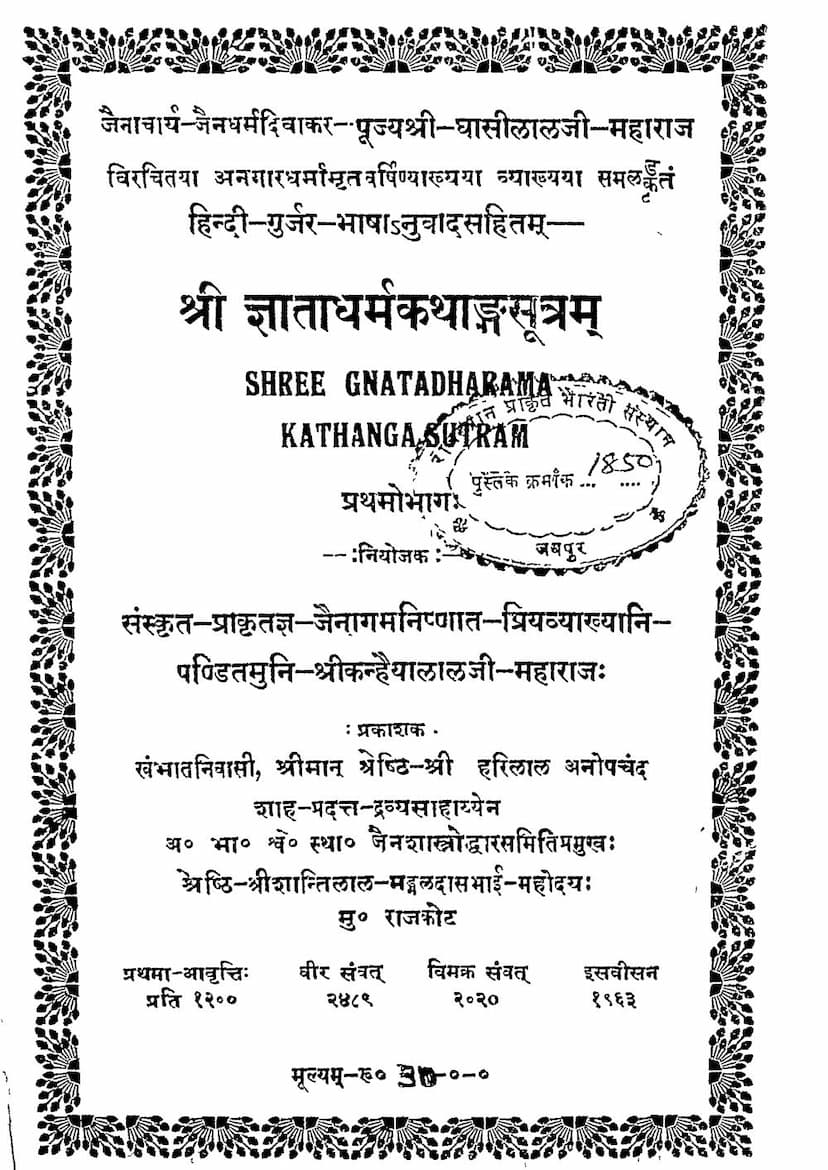Gnatadharmkathanga Sutram Part 01
Added to library: September 1, 2025

Summary
A Comprehensive Summary of the Gnatadharmkathanga Sutram, Part 01
This summary is based on the provided Sanskrit-Prakrit text and its Hindi-Gujarati translation. The Gnatadharmkathanga Sutram, Part 01, authored by Acharya Gyatilal Maharaj and interpreted by Pandit Muni Shri Kanhiyalalji Maharaj, is a fundamental text within the Shwetambar Sthanakwasi Jain tradition. The presented portion of the sutra, as indicated by the table of contents, seems to cover the initial part of the first, second, and third studies, along with a part of the fourth, focusing on the teachings of Lord Mahavir through narratives.
Key Themes and Content:
The text serves as a discourse delivered by the Jain Acharya on the principles and practices of Jainism. It aims to provide spiritual guidance and enlightenment to the audience. The structure and content are typical of Jain Agamic literature, characterized by:
- Māṅgalācaraṇa (Invocation): The text begins with auspicious invocations, paying homage to the Siddha Bhagwan, the liberated souls who have attained eternal bliss and reside in the highest abode. It highlights their detachment from karmic bonds and their state of purity.
- Author's Intent and Gratitude: The author expresses his intention to elucidate the meaning of the Gnatadharmkathanga Sutra through the commentary "Anga Ānanda Vārṣiṇī." He seeks divine blessings for this endeavor and expresses gratitude to his Guru.
- Classification of Jain Āgamas: The text mentions the four types of Anuyogas (disciplines) within Jainism that help in understanding the vast Jain literature (Āgama): Charan-Karananuyoga, Dharma-Kathanuyoga, Ganitanuyoga, and Dravyanuyoga. The Gnatadharmkathanga Sutra is placed under the Dharma-Kathanuyoga, emphasizing its focus on religious narratives.
- Detailed Contents of the First Study (Adhyayan): The table of contents for the first study reveals a significant portion dedicated to the life and teachings related to Meghakumara. This includes:
- Description of Champanagari.
- The Samavasarana (assembly) of Sudharmaswami in Champanagari.
- Discussions between Jambuswami and Sudharmaswami.
- The narrative of Abhayakumara.
- Detailed descriptions of Dharani Devi's dreams and their interpretations.
- The conception and birth of Meghakumara.
- The upbringing and upbringing of Meghakumara.
- The discourse of Lord Mahavir to Meghakumara and his parents.
- Meghakumara's acceptance of asceticism.
- Meghakumara's practice of austere penances (tapas).
- Detailed accounts of Meghakumara's spiritual journey, including his deep meditation and eventual attainment of liberation (moksha).
- Second Study (Adhyayan): This study appears to delve into narratives concerning individuals like Bhadra (wife and merchant), Vijaya (thief), Dhanya Sheth, and Devadatta. It likely explores themes of karma, virtue, and consequences through their life stories.
- Third Study (Adhyayan): The mention of a peacock's egg and the characters of Vijayadatta and Sagardatta suggests stories focusing on themes of renunciation, spiritual pursuit, and perhaps the consequences of actions.
- Fourth Study (Adhyayan): The inclusion of the allegory of the tortoise and jackals regarding the control of senses indicates a focus on ethical conduct and the importance of sensory restraint.
Commentary and Translation:
The text is presented with a commentary ("Anagar Dharma Amrita Varshini") by Meghkumar, which provides explanations and elaborations on the sutra's verses. Furthermore, it includes Hindi and Gujarati translations, making the profound teachings accessible to a wider audience. The commentary highlights the author's deep understanding of Jain philosophy and his ability to present complex concepts in an accessible manner.
Personal and Educational Use:
The disclaimer "JAIN EDUCATION INTERNATIONAL FOR PRIVATE AND PERSONAL USE ONLY" indicates the intended purpose of the text, emphasizing its role in spiritual and ethical education.
Overall Impression:
The Gnatadharmkathanga Sutram, Part 01, as presented, is a rich repository of Jain wisdom, conveyed through engaging narratives and profound philosophical explanations. The emphasis on ethical conduct, karma, renunciation, and spiritual liberation are central to its teachings. The commentary and translations aim to make these essential aspects of Jainism understandable and applicable in daily life for educational purposes. The inclusion of detailed descriptions of rituals, characters, and their spiritual journeys provides a comprehensive insight into the Jain way of life and its ultimate goal of attaining Kevala Jnana and Moksha.